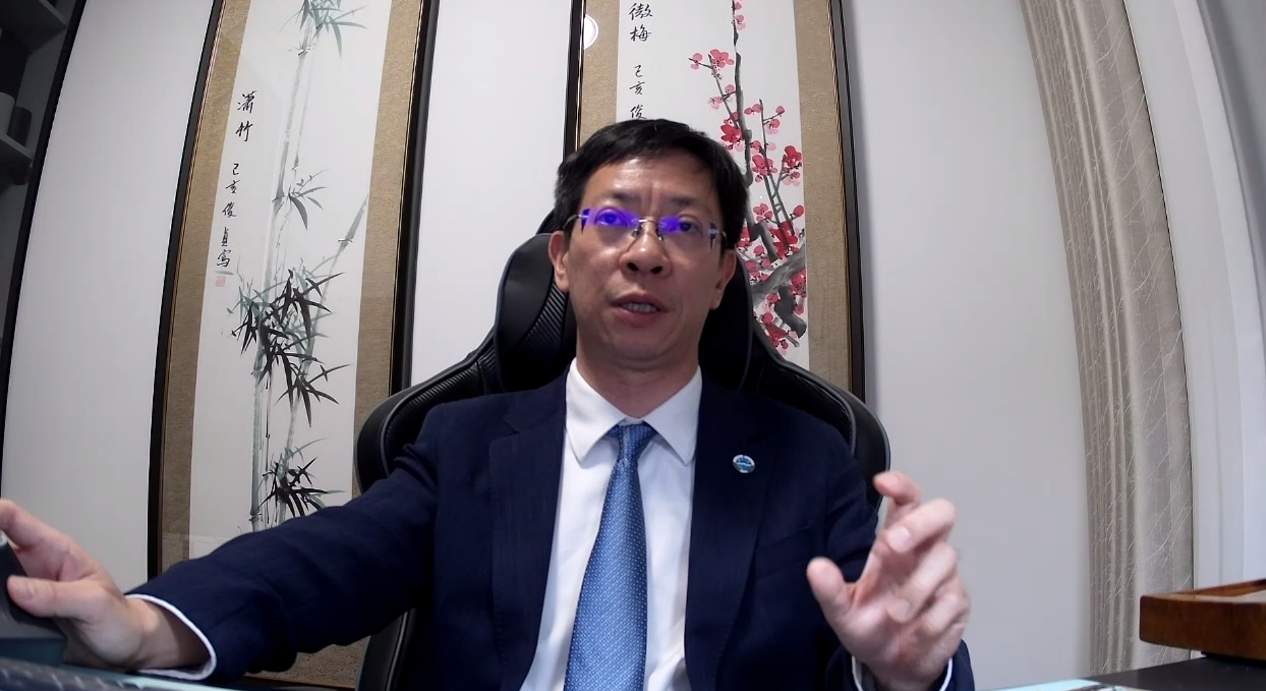On September 24, 2024, Professor Yu Miaojie, a Deputy to the 14th National People’s Congress, a fellow of the International Economics Association, Deputy Secretary of the CPC Committee and President of Liaoning University was invited to attend the sub-forum ‘New York Climate Week 2024’, co-sponsored by the United Nations ‘Trade and Climate: Looking Forward to Emerging Geopolitical Signals’, and delivered a keynote speech online. Hosted by climate organizations, the event is hosted by the United Nations General Assembly every year and together the United Nations and the New York City Government attract senior leaders from business, government, civil society and the climate field around the world. The following is Yu Miaojie’s speech.

Professor Yu Miaojie’s online keynote speech
"Today, I am pleased to share with you our research results on China’s environmental change, energy transformation and its impact on trading partners. These achievements are mainly the results of cooperation with scholars such as Peking University, Liaoning University, Central University of Finance and Economics and Boston University. They mainly focus on two core issues: one is how environmental policies affect trade, and the other is how trade affects the energy transformation of China and its trading partners.
First of all, let’s talk about the first issue: how environmental policies affect trade.
First, ‘green’ is one of the five new development concepts in China. From a macro perspective, in the past decade, China has shifted from high-speed growth to high-quality growth. An important new development concept to promote China’s economic development is ‘green development’, or ‘ecological conservation’. According to the national development plan, China will achieve the peak of carbon emission in 2030 and carbon neutrality in 2060. The use of non-fossil energy is particularly critical in this process. We have set the goal that non-fossil energy consumption will account for 25% of the total energy consumption by 2030. According to the data of 2019, nuclear energy accounts for 2.2%, hydropower accounts for 8% and other renewable energies account for 4.7%, making a total of 15%. Although this proportion has risen to 17.5% this year, there is still a gap to the goal of 25% in 2030, so we still have a long way to go.

Meeting site
Second, the impact of environmental policies on trade. If a country implements stricter environmental policies, the cost of environmental compliance will increase. How will this affect trade? In this regard, we can analyze it from two perspectives. First of all, as environmental policies become stricter, the production costs of enterprises will increase, leading to a decline in their output and thus reducing their exports. On the other hand, stricter environmental policies may push enterprises to adopt more advanced technologies. If these enterprises can achieve technological upgrading and efficiency improvement, it will promote export growth. By making an empirical analysis through transnational data, we found that under strict environmental laws and regulations, exports actually increase while imports decrease, so net exports increase. Its core is that environmental policies play an important role in promoting economic growth and exports by stimulating technological progress.
Third, how environmental policies affect the carbon emissions of China’s exports. First of all, we calculated the carbon emission intensity of different industries by using the data from the World Input-Output Table (WIOD). By comparing the export intensity of carbon emissions per USD 10,000 output, the carbon emission intensities of furniture manufacturing, basic metal industry and chemical industry was in the forefront. If we focus on the total amount of carbon emissions, the case is different. The data showed that the manufacturing of computers, electronic products and optical products are the industries with the highest total carbon emissions. Next, we further analyzed the impact of energy price changes on China’s export carbon emissions. The results showed that if the coal price rises by 10% due to government taxation for some reason, China’s export carbon emissions will decrease by 1.3%. The reason for this change is that when the price of coal rises, enterprises will choose to reduce the use of coal and instead prefer to adopt renewable energies or improve energy efficiency. Especially in the basic metal industry, this effect is more obvious. A 10% increase in coal price can reduce the carbon emissions of the industry by 4.3%. This means that changes in energy prices can significantly affect the carbon emission levels of different industries.

Professor Yu Miaojie answers questions from the audience
Then, let’s talk about the second issue: how trade affects the energy transformation of China and its trading partners.
First, the development of global low-carbon technology trade. China’s position in global low-carbon technology (LCT) trade has changed significantly. In 1992, China’s export share of low-carbon technologies was only 1.1%, but in 2007, this proportion rose to 12.2%. By 2022, this number would further increase to 18%, showing the rapid development of China in the field of low-carbon technologies. We also analyzed the changes in the trade balance of low-carbon technologies in China. In 1992, China was still in a trade deficit in low-carbon technology trade. However, with China’s continuous investment in the field of low-carbon technologies, the export of low-carbon technologies have increased substantially. Today, China has achieved a huge trade surplus in low-carbon technologies, especially in the fields of pollution control, power generation and energy storage. This growth is not only reflected in the export share, but also in the overall trade volume of low-carbon technologies.
Second, the impact of low-carbon technology trade on the environment. We pay attention to the impact of low-carbon technology trade on the environment, which is actually to analyze the contribution of China’s low-carbon technology export to global carbon emission reduction. In the empirical analysis, we used the import data of low-carbon technologies in China in the past year to study its impact on the carbon emission intensity in the next year. We controlled such variables as country, year fixed effect and other necessary control variables. We found that countries that import more low-carbon technologies from China had significantly reduced their carbon dioxide emissions. Whether we measure the carbon emission intensity according to the total amount, logarithm, or considering different standardized methods such as population, GDP, PPP and GDP in fixed or changing years, our research results were still stable. This discovery was especially obvious in the fields of liquid fuel and transportation, showing that the application of low-carbon technologies have effectively reduced the carbon emission intensity of these industries.
Third, the mechanism analysis of the impact of low-carbon technology trade on the environment. When further analyzing the environmental impact of low-carbon technology import, we considered several key factors, including average educational level, political stability, foreign direct investment and foreign aid. First of all, countries with higher average educational level and human capital are more likely to understand and absorb low-carbon technologies, thus reducing carbon emissions more effectively. After the introduction of low-carbon technologies, these countries can quickly transform them into actual productivity and maximize the environmental benefits of low-carbon technologies. Secondly, countries with more stable politics usually have better governance structure and execution, which can effectively implement environmental policies and promote the wide application of low-carbon technologies. Strong government leadership will help these countries achieve their carbon dioxide emission and reduction targets. Thirdly, the inflow of FDI provides more funds for importing countries, enabling them to purchase and apply advanced low-carbon technologies, thus making remarkable progress in reducing carbon emissions. Finally, foreign aid, especially for developing countries, has brought much-needed financial and technical resources to help them reduce carbon emissions while achieving economic growth.
Fourthly, based on the research results, we put forward the following policy suggestions. First, increase subsidies for renewable energy research and development. The export of low-carbon technologies is not only beneficial to China, but also brings remarkable environmental and economic benefits to other importing countries around the world. Therefore, we believe that increasing subsidies for renewable energy research and development is an innovative measure with great potential. The second is to encourage foreign direct investment in renewable energies and low-carbon technologies. By promoting foreign investment in these fields, we can further promote global cooperation and the sustainable development of local economy. The third is to promote trade liberalization. We expect more sustainable trade practices around the world, strengthen the interconnection of supply chains, promote the green transformation of the global trading system and achieve wider international cooperation and resource sharing."
